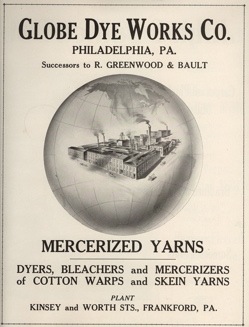
Globe Dye Works, 1865
4500 Worth Street, Philadelphia PA 19124 (north of Kinsey Street, formerly Oxford Street; west to Torresdale Avenue, formerly Little Tacony Creek).
© Barbara M. Auwarter and
Joyce Halley, Workshop of the World (Oliver
Evans Press, 1990).
The original building built
in 1867 by Greenwood & Bault still stands at the
corner of Torresdale Avenue and Kinsey Street.
1
It received its
water supply for dyeing and bleaching of textiles from
the Little Tacony Creek, a large tributary of Frankford
Creek.
Additional buildings were erected in 1871, 1873, 1874,
1880, 1885, and 1891. 2
By 1895, a
corrugated iron covered bridge allowed access to the mill
buildings which had spread across Little Tacony Creek.
Some buildings were razed during this period, and today's
appearance seems to indicate construction well into the
twentieth century. 3
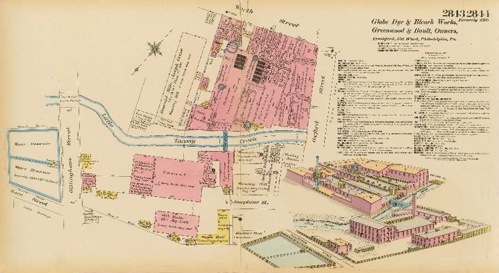
"Globe Dye Works, Greenwood & Bault,
Owners" (1895), Hexamer General Survey
#2843-2844
As was the custom of the time, mill owners leased parts
of their mills to related industries. In 1876 there were
five tenants sharing the mill with Globe Dye Works.
Minnehaha Mills, leased by the Garsed Bros.,
produced cotton goods, such as towels, Cheviotts, dress
goods, and the very famous Minnehaha bed ticks. Steadfast
Mills, leased by Joseph Culbert, produced cotton and
woolen goods, ginghams, miner's flannel, towels, and
crash. The tiny Willow Brook Hosiery, leased by J.
W. Powell & Co., employed five hands to produce
hosiery. No lights were used, and there were no
provisions for extinguishing fire. The Globe
Machine Shop was leased by Clayton Deen.
4
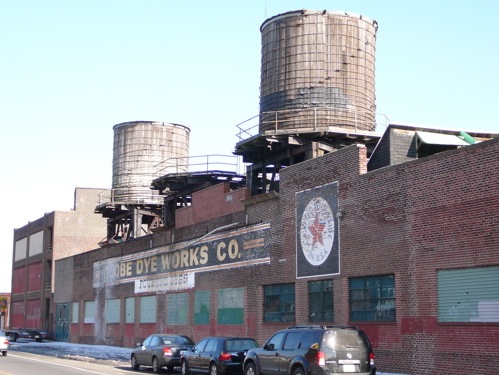
Two water tanks
survive along Torresdale Avenue
(2007).
Massive wooden
water tanks which first appear in a Hexamer Survey of
1895 still make an overpowering statement of the function
of the mill. 5
The complex
maintained its own reservoirs containing one million
gallons of water supplied by artesian wells which
provided water for dyeing processes and fire services. A
steam piston force pump, made by Philadelphia Hydraulic
Works, pumped 750 gallons per minute from the reservoirs,
Little Tacony Creek, and the City water
main.
Globe Dye Works remains a major bleaching and dyeing
house of cotton yarns and warps today. The fourth
generation of the Greenwood family manages, while the
fifth generation works in the business. Not only have the
mills of the Greenwood and Garsed families survived, but
their magnificent houses on Leiper Street in Frankford
have survived as well. 6
The elaborate
Greenwood house of Queen Anne style with nearly
contemporary Tudor solarium porch, porte cochere and
carriage house retains its original elegance and is
enjoyed as a private residence. The Bromley-Garsed house,
built in 1864 in the fashionable Second Empire style, is
now the home of the YWCA of Frankford.
1 "Globe Dye Works, Greenwood & Bault"
(1867), Hexamer General Survey
#334.
2 "Globe Dye & Bleach Works, Greenwood
& Bault, Owners" (1888), Hexamer General Survey
#2198.
3 "Globe Dye & Bleach Works, Greenwood
& Bault, Owners" (1895), Hexamer General Survey
#2843-2844.
4 Hexamer General Survey
#1065-1066.
5 "Globe Dye & Bleach Works, Greenwood
& Bault, Owners" (1895), Hexamer General Survey
#2843-2844.
6 The Foundation for
Architecture Walking Tours, Victorian Frankford, 1987
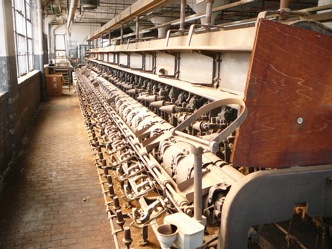
Update May
2007 (by
Torben Jenk):
Globe Dye ceased operations
in 2005 having been managed by five generations of the
Greenwood family, closing that long tradition "You can
rely on Globe." More information is being gathered.
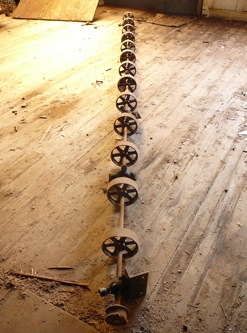
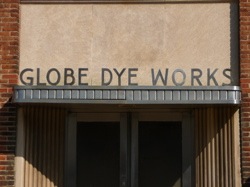
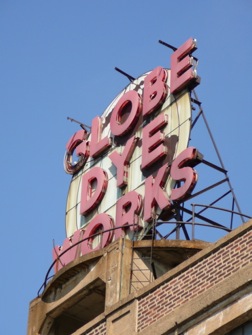
See
also:
"Globe Dye and Bleach Works, Greenwood
& Bault" (1874), Hexamer General Survey
#504.
"Globe Dye & Bleach Works, R. Greenwood
& Bault, Owners; Minnehaha Mills, Garsed &
Co., Lessees; Globe Machine Shop, Clayton Deen,
Lessee; Steadfast Mills, Joseph Culbert, Lessee;
Wiltshire Mills, Stewart Bros. Lessees" (1881),
Hexamer General Survey
#1598-1599.